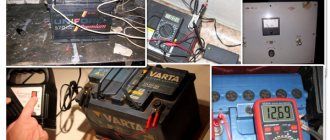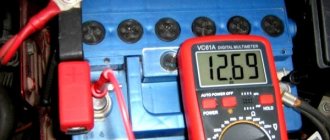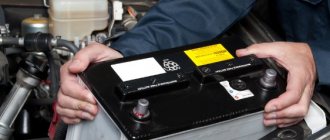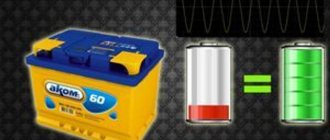The battery (rechargeable battery or battery) is one of the key components of a car. The main role of a car battery is to supply current to the starter when the engine starts. In addition, when the engine is not running, the battery ensures the functioning of various devices (lighting, sound system, signal and other current consumers). When parked, the battery powers the security system. And during a trip, when the generator cannot cope with the load, the battery comes to its aid. Normal functioning of the vehicle's on-board network is only possible with a battery that has a normal charge. Therefore, today we will discuss what the charge rate for a battery is.
WHAT TO DO if the battery is dead, and HOW to start the car in extreme conditions
The approaching cold weather adds not only to car owners the hassle of finding and replacing “shoes” for their pet, but also problems with starting the engine in severe frosts.
At temperatures below 20°C, the battery can lose about half of its capacity in literally 10-12 hours, and these are already critical indicators. The electrolyte, due to its properties, thickens, which helps slow down the chemical reaction to produce and store energy.
However, the battery can run out not only in winter, but also in the warm season, and, often, in the most incredible places.
As a rule, in such cases there is no one to blame, the reason is in ourselves - we worked too intensively with the starter or rested vigorously under loud music and headlights. Therefore, experienced drivers know how to avoid such a situation and are always aware of how long to charge the (car) battery to maintain its working condition.
Preparing the battery for charging
The battery may die for various reasons. Most cases occur due to the driver’s inattention: he forgot to turn off the external lights, did not turn off the ignition, the radio was on all night, the door was slightly open, which caused the lights in the cabin to be on. This is all with the engine not running. Other cases of battery discharge are also possible: problems in the on-board electrical network, the generator has failed, the car has been parked for a long time in severe frost, etc.
After such cases, you will undoubtedly have to charge the battery. First of all, you need to prepare it:
- remove from the car;
- clean the housing from dirt and dust;
- clean the terminals from oxidation;
- bring it into a well-ventilated area (where charging will take place), since charging releases hydrogen, which is a very flammable gas;
- determine a charging location indoors, away from electrical equipment;
- if the battery has been in the cold for a long time, then it must be warmed up in a warm room to +20C; in no case should it be heated with a hairdryer, hot water or other heating devices, the battery must thaw itself.
Basic rules for battery maintenance
Much has already been written about the technology of restoring battery capacity using chargers, so we will limit ourselves to a review of actions for its preventive maintenance . Following simple rules will ensure a reliable start of a cold engine and extend the life of the car battery. The current industry produces several types of batteries, including those that absolutely do not require maintenance - the owners of such products are lucky, they only need to wipe the case in time and inspect it for integrity. Owners of serviced batteries will have to “sweat a little”, that is, perform a number of simple preventive manipulations:
- check the reliability of the battery fastening;
- clean the battery from dirt;
- check the housing for cracks;
- clean the ventilation holes in the plugs;
- check the electrolyte level;
- replenish the level with distilled water;
- charge if necessary.
The frequency of inspection depends on the intensity of use, but it should be carried out at least every 3,000 km.
Attention! When inspecting the battery, do not use open fire - hydrogen, when mixed with atmospheric air, forms an explosive gas, which is explosive!
When installing additional audio equipment or lighting devices, you need to take into account the power of the voltage source and the on-board network, then you will not have problems like “ the battery is dead: how to start the car?” ".
Preparing the battery for the charging process
Before charging a car battery, it is recommended to carry out preparations that include a certain sequence of actions:
- Remove the battery from the vehicle.
- Use a soda solution to clean the battery monoblock from acid residues and contaminants. To prepare this mixture you will need 1 tablespoon of baking soda per glass of water. It is used to weaken the effect of the electrolyte, which contains sulfuric acid and purified water in a percentage ratio of 40 to 60. If during the cleaning process the solution begins to hiss and foam a little, this indicates the presence of excess acid.
- Clean battery terminals. This must be done as they are constantly subject to oxidation. It is recommended to carry out such a procedure in two ways: using cutting tools or flexible abrasive material.
- Wipe the top of the battery monoblock.
- Unscrew the plugs from the battery.
- Inspect the electrolyte level. This procedure can be completed in a few minutes. If the plates are lowered into it by 0.5 centimeters, then this indicates the optimal value of the indicator. In the opposite situation, it becomes necessary to add distilled liquid.
- Make sure the battery polarity is correct and connect a special charger with the output side to the battery terminals.
- Start the charge transfer process.
- Adjust the response and metadata parameters on the device. This action is typical for non-automatic devices.
Inexperienced motorists often have a question: how often should a car battery be charged? Experts recommend doing this once a season, mainly before the onset of winter. However, sometimes additional charging may be required. To determine when to charge your car battery, you need to monitor the engine starting process very carefully. If the starter spins at a standard pace, then no action is required. In opposite situations, it is necessary to solve the low charge problem. Thus, there is no clear answer to the question of how often to charge a car battery, since it depends on a number of uncontrollable factors.
If we talk about whether it is possible to charge a cold car battery, then in winter this should be done every month. Moreover, once a week it is recommended to check the density of the substance that conducts electric current, and daily add distilled liquid before leaving.
Emergency charging, or How long to charge a car battery to working condition
Naturally, it is best to charge the battery in a mode that is gentle on it. But it happens that a discharged source has recently been discovered, and it is simply necessary to go. There are several ways to restore capacity in a short time : .
- Increased charger charging current for 20 minutes.
- The use of a simple electrical circuit in the absence of a charger.
- Using the device for emergency charging.
You need to know that the first option leads to intense wear of the plates and such procedures cannot be carried out frequently. Using a powerful diode or diode bridge together with any load (for example, in the form of a 200 W electric lamp) will help revive the battery if you don’t have an industrial “charger” at hand. By using a 1 kW heater instead of a lamp, you can activate the process. This method should be used only as a last resort and with special care - the parts are live! All of the above methods, including starting devices, are applicable if you have an ordinary outlet, even if not in the garage. What to do if the battery is dead, and how to start the car away from power lines? For such a case, modern industry produces portable power sources for restoring the standard battery, which are connected to the cigarette lighter socket. The manufacturer assures that a completely dead battery will be able to start the engine within 20 minutes. Reviews about this “device” are quite contradictory and, I think, not without reason. Therefore, let's consider alternative methods. Options for starting the engine in urban conditions The presence of city traffic greatly simplifies the task of “revitalizing” your vehicle, because in such conditions it is not difficult to find someone to push, take in tow or give you a light. Another question is how to use this correctly?
or tug
A few sympathetic volunteers - and now the engine is already “living.” But to prevent the “familiar words” of these kind people from being addressed to you, while in the cockpit, you should coordinate your actions according to the following scheme:
- Turn on the ignition.
- Depress the clutch pedal.
- Engage 2nd gear.
- When good acceleration is achieved, release the clutch pedal.
Now one could say that no matter how much you charge a dead car battery, a couple of people are better. But, unfortunately, for cars with automatic transmission or CVT, this method will not work, just like trying to start the engine from a tow.
The actions in the presence of a second vehicle are similar to those described above, with the only difference being greater caution so as not to “ram” the front car.
“Light up” from a car with a working battery
The method is applicable to vehicles with any type of transmission. To start a car with a dead battery using wires and a second donor car, let’s familiarize ourselves with the procedure :
- Turn off the donor vehicle and turn off the ignition.
- Unscrew the negative terminal of the discharged battery.
- Connect the positive terminals of both batteries with a “positive” cable.
- Connect the “negative” cable to the negative terminal of the donor and to the “ground” of the vehicle with a discharged battery.
- Try to test start a cold engine; if unsuccessful, repeat the procedure. In this case, you should pay attention to the operation of the starter; in case of effective “lighting”, it should spin the flywheel well, but if the car does not start, then you should look for other reasons.
- Disconnect the wires in reverse order.
- Connect the negative terminal to the reconditioned battery.
As the list above shows, the procedure is not so simple, although it does not require knowledge of how long to charge a “dead” car battery. The sequence of actions must be strictly followed , otherwise for cars “charged” with electronics, a good deed can turn into an expensive repair.
Let’s consolidate our knowledge of “lighting up” with the help of a video:
Particular attention should be paid to the choice of wires for the “lighting up” procedure. The cross section for gasoline models is recommended to be at least 25 mm, for diesel models - 35 mm. Naturally, the cables must be copper and equipped with reliable clamps. The capacities of both batteries must match. For example, the “ten” will not be able to start a Land Cruiser, especially a diesel one, unless it stops starting on its own.
If you urgently need to go, but the battery is dead
In order to start a car with a completely dead battery, just connect the charger for 10-15 minutes. In this case, you can set the current value to more than 10% of the capacity, for example, 10 A.
Modern automatic “chargers” can be used as starting devices to make it easier to start the engine. To do this, you need to connect it to the battery, set the maximum amperage, wait 10-15 minutes, and then, without turning it off, start the car engine. After the engine has started, the driver needs to drive at least 10 km so that the generator can at least slightly recharge the battery for the subsequent successful start of the engine.
If you don’t have a charger at hand, you can simply “light it” from another car using wires. In this case, after connecting the “crocodiles”, you need to wait a little so that the dead car battery absorbs some energy. Otherwise, when you try to turn on the starter, almost all the current will be spent on charging the dead battery, and you will not be able to start the engine. » alt=»»>
Hi all! Although it is the height of summer, the problem of a dead battery is relevant all year round. I myself have repeatedly encountered a similar problem, so I decided to share with you some methods for solving it. We will talk about how to start a car if the battery is dead.
Sit back, we're about to start. But where to start if the battery is dead?! Anyway. Let's consider several options. Plus, let's look at the video for clarity.
How to start a car yourself if the battery is dead far from civilization. Alternative method
“ Crooked starter ” was the popular name for a device for turning the crankshaft; although it required significant muscle effort, it helped many people out more than once. Unfortunately, most modern cars are deprived of such a useful device, but popular thought also does not stand still - it progresses. And one of her products will help you get out of a seemingly hopeless situation when there is not a soul around. This also requires physical strength. Of course, in such a situation, there will definitely come a time when you will begin to be tormented by remorse and “transparent” thoughts about the forgotten turned-on lamp in the cabin or about how long it took to charge the car battery... But let’s return to the process, you will need the following accessories:
- jack;
- rope or sling 5 meters;
- gloves.
Determining the degree of charge
After completing all the manipulations, it would be useful to check the battery charge level . To do this, you need to check the voltage at the terminals using a load plug. If one is not found, then the easiest way out of the situation would be to install a battery on the car. If we did everything correctly and the charge level is sufficient, the battery will turn the starter in normal mode, and also start the power plant without hindrance.
How to start a car if the battery is dead?
Method 1 “Start-charger” . The easiest and most painless way to start a battery is with a special device. It is connected to the network, the mode switch is set to the “start” position. The positive wire of the ROM is connected to the + terminal, the negative wire is connected to the engine block closer to the starter. Turn the key in the ignition, after the car has started, the starter-charger can be turned off.
This method is suitable for all types of cars (with automatic and manual transmission).
Method 2 “Give me a light!” For this you will need: a donor car - 1 piece, wires for lighting (cross-section more than 16 sq. mm), a key for 10. The battery of the donor car must be in normal working condition, do not try to light a 12-volt unit from a 24-volt volt, the voltage must be the same. An exception is feeding a 24-volt battery from two 12-volt batteries, which are connected in series. Cars are placed next to each other, but they should not touch. The engine of the “donor” is turned off, the negative terminal of the second car needs to be removed. Observe polarity, otherwise the electronics will simply fail. Basically, the negative wire is marked black, and the positive wire is marked red. The positive terminals need to be connected to each other, then we connect the negative to the “donor” and only after that the negative to the car being reanimated. After this, you can start the “donor” for 4-5 minutes so that the “dead” battery is recharged, then you can start the second car and let it run for 5-7 minutes. The terminals are disconnected, let the car run for 15-20 minutes, charging occurs faster when the engine is on.
Method 3 “Increased current” . The battery can be recharged with a higher current; the battery does not need to be removed from the car, but for vehicles with an on-board computer, you need to remove the negative terminal, otherwise the electronics will “fly”. The current can be increased by no more than 30% of the standard readings. For example, for a 60 Ah battery, a current of up to 8 amperes is allowed. The electrolyte level should be normal and the filler plugs should be opened. Charging lasts 20-30 minutes, then you can start the car. Often resorting to this method is not recommended - it shortens the “life” of the battery.
Method 4 “Towing or pusher” . For towing you will need: a cable 4-6 meters long, a towing vehicle. The cars are connected to each other by a cable and accelerate to 10-15 km/h; the towed car needs to engage 3rd gear and gradually release the clutch. If you manage to start the car, you can uncouple the “sweet couple”. The main thing in this method is to coordinate the actions of the drivers, otherwise you can cause serious damage to your neighbor’s vehicle. The method is only suitable for vehicles with manual transmission. You can use human resources instead of a towing vehicle. Accelerate the car downhill or on a flat road. Pushing by the rear pillars or trunks, otherwise you can get serious injuries (for example, slipping and getting run over).
Method 5 “Lithium batteries” . Reviews about it are very mixed; for recharging you can use a laptop, phone, camera and other equipment with lithium batteries. It takes 10-20 minutes to recharge; you can connect it using the car cigarette lighter or directly to the battery. The devices are suitable for all types of cars.
Method 6 “Crooked starter” . Such a thing for cranking the crankshaft helped out many motorists. To do this you will need a jack, 5-6 meters of thick rope or sling. Using a jack, you need to raise one of the drive wheels, wrap 5-6 meters of rope around it, turn on the ignition and direct transmission. Pull the end of the foot with a sharp movement; you need to spin the wheel thoroughly.
We hope that our article will be useful to you, and in an emergency situation you will not be confused and use these tips!
Why does the battery drain?
Any battery, even the highest quality, discharges on its own over time, and this happens for various reasons.
5 reasons why your battery drains quickly
- The battery has expired (4-5 years);
- The generator does not charge the battery during the trip;
- There is a current leak in the on-board network;
- Forgot to turn off the headlights or radio for a long time;
- Exposure to critical temperatures (severe frost).
How to avoid frequent discharges and how to extend the life of a car battery - read on, we have collected all the useful tips on this topic in one convenient list.
11 tips to extend battery life
- Do not run the engine frequently for short runs.
- Do not leave the battery in a discharged state; keep it charged.
- Do not allow your car battery to be completely discharged frequently.
- Do not allow the plates to become exposed, check and add electrolyte to the required level.
- Check the tension of the generator belt and replace the belt if it is very loose.
- Visually check the wiring in the network to promptly eliminate current leakage.
- Watch the contacts connecting to the battery - they may oxidize, wear out or become damaged.
- Make it a rule in any situation to check the car inside and out when you arrive at your destination. All electrical appliances and lights must be turned off.
- In severe frosts, disconnect and move the battery to a warm room.
- In cold weather, charge the battery to the maximum more often so that the frost cannot completely discharge the battery.
- In winter, use special “warming” covers for your car battery.
Kolodiychuk Andrey
, especially for ByCars.ru
When using this material, a link to https://bycars.ru/ is required.
Published 01/01/70. This page has been viewed 531953 times
It’s been a long time since I had to start a car with a dead battery, but a couple of times before. The main thing is that there is somewhere to at least minimally accelerate the car, engage the gear and you’re done.
Once, at the dacha, I forgot to turn off the headlights and discharged the battery, and the automatic transmission couldn’t be started from the pushrod. I had to ask a neighbor to drive up the hood to the hood, hook up the wires to its battery and start it up. In principle, nothing complicated.
I myself have never had to start a car with a dead battery, but in theory I know what to do, and male drivers will always be happy to help a girl. Moreover, for such a case I have special wires with clamps in the trunk.
I remember from the recent past, when driving through Belgorod, my father and I got stuck right in the middle of a busy highway, the feeling of helplessness and the impressions of the trip were remembered for the rest of our lives. They pulled us out using method No. 4 - towing, for which many thanks to the caring townspeople. Now, having learned from bitter experience, we use method No. 1 - a charger.
How to charge if there is no charger
The simplest method of powering a component is to light it from another machine. After this, you need to travel by car for at least half an hour.
The main success factor is considered to be crankshaft speed, varying from 2900 to 3200 rpm.
At these parameters, the generator supplies direct current, which resuscitates the power source. Important! This method is only relevant if the battery is partially discharged. If the battery is deeply discharged, it is still necessary to fully charge the battery.
How to charge a car battery correctly and for how long?
Introduction
A novice car enthusiast faced with a discharged battery is faced with a pressing question: how long does it take to charge a car battery with a charger? There are many different design features of batteries: there are serviced and maintenance-free models: antimony and low-antimony batteries, calcium, hybrid, AGM and gel batteries, alkaline and even lithium-ion batteries similar to batteries on phones. An ordinary charger will not work: each type of battery has its own charger, as well as its own charging method. In addition, parameters such as capacity, wear, and battery charge level play an important role, on which the charging time depends. Let's look at all the important points in detail.
Characteristics of charge parameters
The main parameters considered when recharging batteries are the battery voltage characteristics. It is measured in volts and when the battery is fully charged it ranges from 12.6 to 12.7 Volts (some models have higher voltages). Accordingly, at a lower voltage, for example, 12 Volts, the capacity level of a car battery will be lower, at approximately 40-50% of its capacity. So, with a battery voltage of 11-11.5 Volts, the car battery will be in a state of deep discharge, and the battery capacity will drop. The capacity of a battery is its ability to power a load connected to it, and is measured in ampere-hours or milliamp-hours. That is, a 50 A*h battery means that with a vehicle network load of 50 Amperes, the battery will work for 1 hour, and if the same load is 10 Amperes, then the operating time until completely discharged will increase to 5 hours. To learn how to charge a car battery, an indispensable condition is to understand what possible charging methods are available and what is required for this. Conventionally, there are three types of recharging: · direct current – relevant when the battery is in a state of deep discharge, it restores the capacitance value, but takes quite a lot of time; · constant voltage - a simple method. It does not take much time, it is relevant for chargers operating in automatic mode. · accelerated. A method of emergency battery charging to increase its capacity and start the electric motor of a vehicle. Special tools for monitoring the charge level of car batteries that may be needed: a suitable charger, an avometer (also known as a tester, also known as a multimeter), a device for determining the density of liquid substances - a hydrometer.
Differences in charging different types of batteries
The beauty lies in maintenance-free batteries - the presence of the electrolyte in a sealed case eliminates the need to perform complex operations of monitoring its density and calculating charging parameters. It is enough to connect an automatic charger. The serviced type requires battery care: topping up electrolyte, monitoring its density, and timely charging. Therefore, we will analyze in detail how long it will take to charge it. Basics of safe work when charging batteries Interaction with serviced batteries requires compliance with safety regulations: the electrolyte contains a sulfuric acid solution. You will need thick rubber gloves and safety glasses. The room must be well ventilated. Welding, cutting and open fire are prohibited.
One of the measures to determine what charge capacity a car battery has is to measure the density of the electrolytic liquid. The operation is carried out at the preparatory stage before the charger is connected. Batteries should be charged taking into account the charge level, using technical means and a device that will be most efficient for this type of battery. Table of electrolyte readings in battery banks when using a manual charger.
Density level of electrolytic liquid in battery banks, g/cm3 at a temperature of 15 degrees Celsius
Voltage, Volt (without operating voltage)
Voltage, Volt (with voltage 100 A)
The battery is charged by %
Threshold value of freezing temperature of electrolytic fluid, degrees Celsius
Recharging time using DC method, h to 100%
Recharging time using constant voltage method, h to 100%
Before charging the battery
Before charging the battery, you need to perform a number of steps. First of all, unscrew the terminals and remove the battery from the car. On the Internet we come across a number of tips for charging the battery directly on the car, without even removing the terminals. Please remember that this is not recommended. The battery, of course, is not a light thing, but it is better to take the trouble to remove it from the car for charging.
What is useful for proper battery charging:
- Charger;
- multimeter;
- hydrometer.
To understand how much to charge the battery
car, you need to know about the main methods of charging the battery. There are three ways:
- charge with constant current. This method is great for deep battery discharges. It allows you to fully restore the battery capacity. The charging time for all this is quite long;
- charge with constant voltage. Most chargers use this method, operating in automatic charging mode. Simpler and faster than the first method;
- accelerated charging. This popular rumor mode will be required in a situation where there is no time to fully charge the battery. Using this method, the battery quickly gains the capacity needed to start the engine.
Now let’s look at these methods in more detail, and find out how long it takes to charge the battery in each of them.
Read:
Attention! When working with the battery, remember safety precautions. The electrolyte is dilute sulfuric acid. Since this is a caustic substance, you must wear gloves and safety glasses when handling it. The battery should be charged in a well-open room due to the release of hydrogen. It is prohibited to carry out welding, cutting or other work involving open flames and sparks near the charging point.
How long to charge a car battery
Issues discussed in the material:
- How does a car battery work?
- How long does it take to charge a battery at constant current?
- How long does it take to charge a car battery at constant voltage?
- What are the safety rules when charging a battery?
Before use, each battery must be carefully prepared, otherwise you risk encountering a variety of troubles. This device contains dangerous chemicals inside that can harm your car. It is for this reason that it is important to know how long to charge your car battery.
How far do you need to drive for the battery to charge?
Each car is equipped with an electricity generation device that allows you to charge the battery while driving, it also takes on part of the load when using maximum electricity.
The only problem is that if the car has frequent downtime and the driver drives short distances, the generator will not have time to fully restore the battery capacity and it will eventually be completely discharged.
How does a car battery work?
In winter, owners are faced with the acute issue of charging their car’s battery, because starting in the cold can instantly discharge the battery. Often, old batteries are simply handed over to buyers and new ones are purchased, but there are also vehicle owners who recharge them for further use. Modern car batteries can last you up to 5 years, but this is only if you use them correctly. Otherwise, for example, if the current is supplied incorrectly or the charging time is incorrect, the battery will quickly fail.
To correctly approach charging a car battery, you first need to understand the special terms. For example, capacity is measured in ampere-hours, that is, if you see the inscription 60 A on your battery, therefore, it delivers exactly this amount of charge per hour. In addition, if the load drops to 30 A, it already takes two hours to release a charge of 60 A, etc. It turns out that depending on how many amperes are at the output, it takes a different amount of time to charge the car battery at a certain speed. If you don't take this point into account, you'll be in trouble.
It so happens that the normal voltage of a car battery is considered to be 12 volts, however, this is not entirely true. This value is average. Typically, a working battery has a charge of 12.6–12.7 V. This is a fully charged car battery.
We recommend
At 12 V, the battery charge will be approximately 50%. It's quite possible to travel with it. After all, with a fully functioning system in your car, the charge will quickly reach 100%. Separately, it must be emphasized that a charge indicator of 11.5–11.6 V indicates the so-called “deep charging”. This has an extremely adverse effect on the car battery: a process of “sulfation” of the internal lead plates occurs, which significantly reduces the battery capacity. In some cases, the car simply may not start.
Therefore, to function properly and deliver 60 amps per hour, your car battery needs to have a charge of 12.7 V. After use, it will drop to 11.6 V and will need to be recharged. And so the process repeats in a circle.
How to properly charge with a charger: preparation
Before you start eating, you need to perform a number of preparatory steps:
- Remove condensation, corrosion, and dirt from the contacts. Use a soft cloth that can be soaked in either a specialized product or a soda solution. Remove dirt thoroughly;
- Check the condition of the electrolyte. If it is not enough, add clean water, preferably distilled, otherwise the battery will be damaged.
After the above activities, you can begin the nutrition process. This is done using direct current or voltage. Charging time may vary. This does not apply to universal memory devices.
How long does it take to charge a car battery at constant current?
To charge the battery using DC current, go through several steps step by step. This information will also be relevant to you if you want to know how much to charge a car battery at 60 amperes per hour. Use chargers that can be adjusted manually and keep the entire process under personal control. Calculate the supplied current correctly. It should be no more than one tenth of the calculated battery capacity. For example, if your unit has a rated capacity of 55 A, then it must be serviced at a current of 5.5 A. If these requirements are met, charging will take 9-10 hours. If the current decreases, the time for full charging increases accordingly. And vice versa.
Chargers allow you to set the required current. Remember that the battery must be charged until the voltage reaches the design level of 14.4 volts. It is advisable to use a tester for control.
After reaching 14.4V, reduce the current value from 5.5 to 2.75 or from 6 to 3, depending on the type of your car battery. Remember to check the voltage every 2 hours.
The battery receiving a 15 volt charge is a sign for the next reduction in the current value. Let's give an example. If your battery has a capacity of 55 ampere-hour, set the value to 1.375 A. To calculate this indicator for your device, use the formula: AC capacity * 10% / 4. Continue charging and monitor the process every 2 hours. When the multimeter stops recording an increase in voltage, you can stop charging.
The time to fully charge the battery is an individual indicator. It may depend not only on the type of car battery, but also on its ability to accept a charge. There are batteries that need more than a day to fully charge. The only thing worth saying is: the newer the unit, the more time it takes to fully recover. So, a new car battery needs approximately 1–2 days to charge, while an already used battery will require about 12–16 hours.
Assessing the condition of the battery
When analyzing how to properly charge a battery, it should be noted that you need to start by studying information that includes information about assessing the condition of the battery. So, this can be done using three methods:
- According to the built-in indicator, which is installed on most modern batteries. It is a ball that changes colors depending on the charge. If the tint turns green, the car is operating at an optimal level. In situations where the color changes to white, it is necessary to charge the battery. There are moments when the indicator turns black. This indicates insufficient electrolyte levels.
- Using a professional electrical measuring instrument called a multimeter. It allows you to determine the degree of discharge of the battery. In other words, this device measures the voltage at the terminals, which should exceed 12 volts. Correspondence between voltage and charge magnitude
Voltage degree, V Charge level, % 10,5 0 11,58 20 11,9 40 12,2 60 12,42 80 12.6 or more 100 - Using a load coil. Practice shows that this method is the most reliable to determine whether the car battery needs to be recharged or not. Moreover, such a reel can be purchased at any store specializing in the sale of accessories for cars.
How long does it take to charge a car battery at constant voltage?
Constant voltage is the basic principle of charging a car battery. The system supports it automatically. In addition, a special indicator indicates the charge level. This ensures a smooth battery charge, eliminating sudden surges.
How long does it take to charge a car battery with a constant voltage charger? Such devices are distinguished by an automatic terminal voltage regulation system. When using it, the internal resistance in the car battery drops in proportion to the decrease in current strength and the increase in capacity charge. When charged at 200 milliamps, the device turns off. This is a fully automated process, and the battery owner does not need to control the charge.
How long does it take to charge a car battery to reach 100% capacity? It will take at least a day to reach a voltage of 14.4 V. And in percentage terms, the capacitive charge will reach 80%. If you charge the battery at 15 V, then it will take a day to reach 90% charge. Therefore, for your car battery to receive a 100% charge, you need at least 24 hours at 16 V.
This is a very simple method, and therefore very popular. It is great for beginners who are not very knowledgeable about the structure of a car, as it requires minimal training.
Charging process, step-by-step instructions
The battery is a source of direct current, so it is charged by a “rectifier”. The charger consists of a step-down transformer, a diode bridge, a control panel with instruments and output terminals.
The variety of devices is large and depends on the manufacturer. Most of them have automatic or semi-automatic control, which simplifies the charging process.
Connecting the charger to the battery
The connection occurs as follows:
- 1. Connect the terminals from the charger to the battery, observing the polarity. "Plus" - red wire to "plus", "minus" - black wire to "minus".
- 2. On the control panel, set the parameters: voltage (U), current (I).
- 3. Plug the power cable of the device into the network.
- 4. Press the “On” button on the device.
Disabling occurs in the reverse order.
Setting up the charger
To configure the rectifier for charging, you need to decide in what mode it will occur.
There are two modes: constant current and constant voltage.
Constant current charging
This is an effective mode. It makes it possible to fully charge the battery in a short time, however, it requires control and intervention during the process:
- Initially, to charge the battery, we set the charging current equal to 10% of the battery capacity (for example: capacity 60 A/hour, current 6 A);
- charge until the voltage at the terminals reaches 14.4V;
- after this, we reduce the current to 3A and continue charging until the release of gases begins:
- the battery is considered charged if the voltage and current remain unchanged for one to two hours;
- The battery is fully charged in approximately 10 hours.
Constant voltage charging
This mode is simpler, but longer; the battery does not receive a full charge, but only 80% - 85%.
In this process, the voltage is set within 14.4 - 14.5V, and charging is turned on. The initial charging current is high, can reach 50A, so the charger must be equipped with current limiting protection up to 20A.
As the battery charges, the current will drop to zero and the voltage will be equal to the rectifier voltage.
In practice, in this mode, the battery is charged for more than a day and at 80%.
A few notes and tips when charging the battery:
- the caps in the cans must be removed to allow gas to escape;
- if the battery temperature rises (40C - 50C), charging must be turned off and turned on again after cooling;
- check the electrolyte level in the jars; if it is lower, add distilled water (not plain water, not boiled water, and not electrolyte).
Accelerated battery charging
This method is used in emergencies, and it looks like regular charging at a constant current. Only for this purpose the charging current is set not to 10% of the battery capacity, but to 20%. That is, with a capacity of 60 A/h, the current is set to 12A. In a short time the battery will not be charged to 100%, but it will be enough to start the engine.
In this process, special attention must be paid to the temperature of the electrolyte, not to allow it to overheat above 45C - 50C.
This "draconian" charging method is best avoided if possible, otherwise it will lead to rapid failure of the power supply.
Battery check and prevention
The battery should be kept clean, especially its terminals, which are subject to oxidation. Periodically, at least twice a year, check its condition and carry out preventive work, starting with an external examination:
- the housing and terminals must be clean, without mechanical damage; if present, remove it;
- if the battery has an elevated temperature, perhaps one or more cans are shorted, that is, lead sulfate crystals have formed between the plates (it is impossible to fix this, especially on your own, but in some cases technicians can help);
- we measure the voltage between the terminals, it should be in the range from 12.6V to 14V, if less, then the source must be charged.
After an external examination, making sure that the battery is in order and all defects have been corrected, you need to measure the density of the electrolyte. There is a special device that is affordable and easy to use, called a hydrometer.
Density should be measured in jars; in a charged battery it should be from 1.27 to 1.29 g/cm3. The density difference between banks should not exceed 0.02 g/cm3. If in one of the cans the density is lower than in the others by 0.10 - 0.16 g/cm3, then a short circuit has probably occurred in it.
If during measurement the voltage is below 12.6V and the density is less than 1.24 g/cm3, then the battery must be charged.
All measurements are given on average at a temperature of +25C.
By doing these manipulations periodically, you can ensure that the battery will work for a long time and without failure, despite the seasons.
How long does it take to quickly charge a car battery?
This method is only suitable for one-time starting of the car engine. It can only be used on modern charging devices. The process itself takes 20 minutes. Strictly monitor the time, as charging for too long can lead to battery damage.
It happens that chargers do not have an accelerated mode. In this case, all control is carried out manually. Set the current to no more than 25-30% of the standard. Exceeding this figure negatively affects the life of your car's battery.
Use a multimeter (load fork) in your work. This device allows you to competently control the voltage level and determine the correct degree of charge of the car battery.
It would also be a good idea to use a hydrometer. It sets the density of the electrical composition, which affects the state of charge. The density is checked in each jar. Pay close attention to this indicator, because it determines how long to charge the battery at a constant or fixed current.
Methods for charging a car battery
There are three main ways to properly charge a battery:
- Direct current. This technique is used to remove lead sulfate residue from the plates that has accumulated over time. This type of charge is called equalizing. This method is also suitable for emergency revitalization of the battery. We are talking about forced charging.
- Constant tension. In this method, two groups are distinguished. The first includes a charge of a modified plan, the second - a continuous recharge.
- Combined. Includes a two-step process.
Let's take a closer look at each method by which you can charge the battery.
Safety rules when charging a car battery
Remember that it is very important to strictly follow safety rules when charging your car battery.
- The process must take place in a closed and ventilated room in compliance with the required temperature conditions. Do not forget that toxic substances released during charging can harm your body.
- It is strictly forbidden to place heaters and heating devices near a car battery, since the substances released during charging can detonate when in contact with an open flame.
- The charging surface must be flat and free of dust.
- Do not move the battery while charging for a long time.
- Be sure to use gloves. Remove rings and other metal items from your hands. Contact with any metals has unpleasant consequences.
- Don't forget about the polarity of the terminals. Pay special attention to this when connecting them.
- All valves located on the battery open before connecting the charger. After all, in a sealed housing the pressure will increase quite quickly.
- Use only certified chargers. Any homemade units lead to battery failure.
In order to wisely choose a method for charging a car battery, it is worth taking into account the timing of the work, as well as the conditions for its implementation. Feel free to use automated battery charging devices. This will make the process much easier.
In conclusion, advice: in order to increase the life of the battery, it is necessary to provide it with high-quality and proper care in a timely manner. Take the time to charge and follow all technical instructions when performing this process.
Available means
When studying the question of how to charge a battery, it can be noted that it is not necessary to use a special charger. It's easy to make it yourself. However, this poses a certain danger if you do not have an understanding of the basics of such a process. Moreover, not all drivers know how to charge a car battery using various available means. There are several ways to make such devices with your own hands:
- Use a standard household outlet for charging, the voltage of which is 220 volts. To do this, it is recommended to use an electronic device made of semiconductor material and technical devices capable of converting energy.
- Take a secondary power source. For example, a power supply from a laptop or computer. Such a device is capable of providing a voltage of 13–14 volts and a current of more than 1 ampere.
It should be remembered that it is necessary to constantly monitor how the car battery is charged. Proper regulation is carried out not only on the basis of periodic measurements at the battery terminals, but also on the calculation of the time interval.
Charging car batteries using improvised means requires great care, as they provoke increased heating of the battery. This in turn leads to a significant release of chemical elements such as oxygen and hydrogen. Improper use of devices can lead to dangerous situations such as damage, flames, and burns.
Precautionary measures
To avoid unpleasant consequences when charging a car battery, you must follow several effective recommendations:
Remember that there is acid in the battery banks, so it is better to use basic personal safety equipment when working - gloves and goggles .
It is important to understand that the charging process is accompanied by the evaporation of various harmful gases, so it is better to carry out this process in a room that is sufficiently ventilated.
In addition to dangerous gases, hydrogen is also released , which can interact with oxygen. In other words, if even a small spark occurs in such a room, an explosion may occur.
Basically, that's all you need to know about charging your car battery. Compliance with the correct sequence and basic safety standards will allow you to carry out this process correctly.











